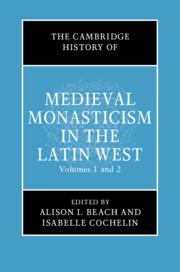Book contents
- The Cambridge History of Medieval Monasticism in the Latin WEST
- The New Cambridge History of Medieval Monasticism in the Latin West
- The Cambridge History of Medieval Monasticism in the Latin WEST
- Copyright page
- Contents
- Figures
- Contributors
- Acknowledgments
- Abbreviations
- 1 General Introduction
- Part I The Origins of Christian Monasticism to the Eighth Century
- Part II The Carolingians to the Eleventh Century
- 18 The Historiography of Central Medieval Western Monasticism
- 19 Sources for the History of Monasticism in the Central Middle Ages (c. 800–1100)
- 20 Questions of Monastic Identity in Medieval Southern Italy and Sicily (c. 500–1200)
- 21 Discerning “Reform” in Monastic Liturgy (c. 750–1050)
- 22 Monasticism, Reform, and Authority in the Carolingian Era
- 23 Carolingian Monastic Schools and Reform
- 24 Monastic Economics in the Carolingian Age
- 25 Missions on the Northern and Eastern Frontiers, c. 700–1100
- 26 Minsters and Monasticism in Anglo-Saxon England
- 27 Monastic Art and Architecture, c. 700–1100: Material and Immaterial Worlds
- 28 Monastic Daily Life (c. 750–1100): A Tight Community Shielded by an Outer Court
- 29 The Double Monastery as a Historiographical Problem (Fourth to Twelfth Century)
- 30 Interactions between Monks and the Lay Nobility (from the Carolingian Era through the Eleventh Century)
- 31 Monastic Reform from the Tenth to the Early Twelfth Century
- 32 Monastic Canon Law in the Tenth, Eleventh, and Twelfth Centuries
- 33 Eastern Influence on Western Monasticism, 850–1050
- Part III The Long Twelfth Century
- Part IV Forms of Monasticism in the Late Middle Ages
- Index
- References
18 - The Historiography of Central Medieval Western Monasticism
from Part II - The Carolingians to the Eleventh Century
Published online by Cambridge University Press: 16 January 2020
- The Cambridge History of Medieval Monasticism in the Latin WEST
- The New Cambridge History of Medieval Monasticism in the Latin West
- The Cambridge History of Medieval Monasticism in the Latin WEST
- Copyright page
- Contents
- Figures
- Contributors
- Acknowledgments
- Abbreviations
- 1 General Introduction
- Part I The Origins of Christian Monasticism to the Eighth Century
- Part II The Carolingians to the Eleventh Century
- 18 The Historiography of Central Medieval Western Monasticism
- 19 Sources for the History of Monasticism in the Central Middle Ages (c. 800–1100)
- 20 Questions of Monastic Identity in Medieval Southern Italy and Sicily (c. 500–1200)
- 21 Discerning “Reform” in Monastic Liturgy (c. 750–1050)
- 22 Monasticism, Reform, and Authority in the Carolingian Era
- 23 Carolingian Monastic Schools and Reform
- 24 Monastic Economics in the Carolingian Age
- 25 Missions on the Northern and Eastern Frontiers, c. 700–1100
- 26 Minsters and Monasticism in Anglo-Saxon England
- 27 Monastic Art and Architecture, c. 700–1100: Material and Immaterial Worlds
- 28 Monastic Daily Life (c. 750–1100): A Tight Community Shielded by an Outer Court
- 29 The Double Monastery as a Historiographical Problem (Fourth to Twelfth Century)
- 30 Interactions between Monks and the Lay Nobility (from the Carolingian Era through the Eleventh Century)
- 31 Monastic Reform from the Tenth to the Early Twelfth Century
- 32 Monastic Canon Law in the Tenth, Eleventh, and Twelfth Centuries
- 33 Eastern Influence on Western Monasticism, 850–1050
- Part III The Long Twelfth Century
- Part IV Forms of Monasticism in the Late Middle Ages
- Index
- References
Summary
Unlike Eastern monastic historiography, for which historians have never constructed a coherent narrative, the story of central medieval Latin monasticism once seemed to be simplicity itself. The sixth-century Rule produced at Benedict of Nursia’s Montecassino (RB), which observers likened to Mount Sinai as a source of sacred law, was said to have been quickly adopted in all Western monasteries outside Iberia. However, “the rule came to be far too laxly followed in many Benedictine monasteries, and in 910 the order of Cluny was founded to renew its strict observance.” The efforts of tenth-century monastic reformers associated with Cluny transformed decadent monasteries into observant institutions and guaranteed that the RB “became for three centuries the uncontested source of all European religious life.” Thus, one survey of medieval Western monasticism covered the central Middle Ages in eight pages devoted to “the formation of a Benedictine tradition and the contribution of Cluny.”
- Type
- Chapter
- Information
- The Cambridge History of Medieval Monasticism in the Latin West , pp. 365 - 381Publisher: Cambridge University PressPrint publication year: 2020
References
- 1
- Cited by

